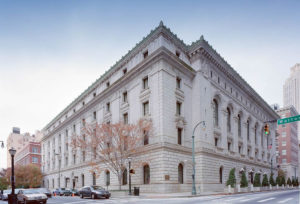
UPDATE: 11th Circuit backs shops on steering, nixes antitrust, enrichment claims
By onBusiness Practices | Insurance | Legal | Market Trends
Despite prevailing before a three-judge Eleventh Circuit Court of Appeals panel in 2017, eight auto body shops in four states lost big Monday as the full court ruled 8-1 a Florida judge was right to dismiss their lawsuits alleging insurer antitrust violations and unjust enrichment.
However, the Eleventh Circuit did find the shops in Kentucky, Virginia, New Jersey and Missouri presented a sufficient case to go to discovery on state tortious interference — steering — allegations against the nation’s largest insurers. Attorney John Arthur Eaves Jr. once called the steering claims in a related Mississippi lawsuit “the biggest part of the case.”
Campbell v. State Farm (Kentucky), Lee Pappas v. State Farm (Virginia), Quality Auto Painting v. State Farm and Ultimate v. State Farm (New Jersey) and Concord v. State Farm (Missouri) had filed a single consolidated appeals brief, urging the Eleventh Circuit to clear up the murky status of just how specific any federal lawsuit had to be to survive a motion to dismiss.
The five cases had been dismissed without prejudice by Middle District of Florida Judge Gregory Presnell and appealed without being amended to correct what Presnell considered deficiencies. Despite being filed in separate jurisdictions, a federal panel deemed the cases similar enough to consolidate before Presnell’s court.
After losing 2-1 before the three-judge panel in September 2017, insurers in 2018 successfully petitioned for an en banc hearing. Law.com in October 2018 reported multiple judges seemed skeptical during oral arguments.
On Monday, the full Eleventh Circuit court demonstrated that skepticism by upholding Presnell’s decision to toss most of the case but declaring the lower-court judge’s grounds for dismissing the tortious interference claims incorrect.
Judge Charles Wilson provided the only dissent in the 8-1 decision, writing that shops should have been allowed to proceed to discovery in on the antitrust.
The majority ruled that when the body shops were alleging every defendant was steering, they clearly meant every defendant was steering — there was no confusion about who was accused of what. Presnell never seemed be able to get that through his head as these and other states’ lawsuits moved through his courts — despite what opinion author Circuit Judge R. Lanier Anderson noted was language in the appealed complaints explaining “‘Defendants’ is intended to and does mean each and every Defendant.”
The Eleventh Circuit felt the same held true for the question of who was supposed to have been wronged by the steering alleged in the lawsuit. With only one plaintiff in four of the five cases, it was obvious who was harmed, Anderson wrote. In the fifth case, it was “amply clear” that all four body shops named as plaintiffs were alleged to have suffered tortious interference, Anderson wrote.
Finally, the court didn’t mind that the shops didn’t identify specific steered customers in the five cases, ruling that the shop would have been the victim of the alleged offense.
“We cannot conclude that the Body Shops’ failure to identify particular potential customers who were steered away constitutes a failure to give each defendant fair notice of the claim against it,” Anderson wrote. “It is not the potential customer who is the target of the alleged tortious interference; it is the targeted Body Shop. A potential customer may—but very well may not—tell the Body Shop that he or she was steered away. On the other hand, each Insurance Company, or its claims adjusters, will know whether the company engages in such a practice, and will know whether each named Plaintiff in the five complaints was noncompliant with that company’s preferred practices and, most important, whether its insureds were steered away from that Plaintiff Body Shop.”
Anderson wrote that since the federal antitrust claims had been “eliminated,” Presnell might not want to bother hearing the state-level tortious interference cases. This could potentially shift some of the cases back to their original jurisdictions.
Part of the full panel’s resistance to the shops’ antitrust appeal stemmed from the repairers’ attorneys sticking new information in their arguments to the Eleventh Circuit rather than bolstering their actual Middle District of Florida complaints with amendments. This makes one wonder if one a dismissed-with-prejudice lawsuit — i.e., no amendments — might have fared better on appeal.
“At the outset, we address an issue regarding the complaints,” Anderson wrote. “The first is merely an observation of the time-worn principle that it is only the factual allegations contained therein which we must accept as true. The Body Shops’ appellate briefing takes undue liberties in construing the inferences that can be fairly read from their pleadings. The district court dismissed these claims without prejudice and, therefore, the Body Shops had an opportunity to amend their complaints to include any additional allegations that may have been omitted from their initial pleadings. Having chosen not to do so, they are not permitted to simply ‘insert’ new allegations through their appellate briefing.”
The shops had argued that the insurers all insisted on paying a uniform price despite variables which should produce a variety of prices, according to Anderson. But the case cited as support for this point involved virtually identical secret, sealed bids on cement, according to Anderson. It went “beyond that of mere conscious parallelism,” he wrote.

The shops alleged that because State Farm didn’t publicly disclose its market rate, the insurers must be matching it under a price-fixing agreement. But Anderson and the court felt the shops didn’t present enough evidence to rule out the insurers figuring out that rate anyway.
“As an initial matter, alleging that State Farm does not publicly disclose the market rate and arguing that it is a secret are two very different things,” Anderson wrote. “The fact that State Farm does not issue a press release with the market rate does not foreclose the possibility that it is publicly known. This is a crucial distinction.
“There are no factual allegations that the market rate is a secret. Indeed, nowhere in the complaints do the Body Shops suggest that the labor rate is a secret. Quite the opposite, the complaints reveal that State Farm must necessarily tell the rate to every repair shop in a given geographic area.”
Anderson also observed that the carriers weren’t even alleged to have “simultaneously approached the Body Shops with an identical market rate.” Instead, based on the shops’ own accounts, insurers just let their rates float to whatever State Farm’s was, the judge wrote.
“Following the example set by a competitor, without agreeing to do so in advance, is textbook ‘price leadership'” and not enough grounds to allege price-fixing by itself, according to Anderson.
“In this case, the Body Shops’ own allegations put a nail in their coffin,” he wrote. “Their own allegations explain why there is uniformity in price—the other Insurance Companies simply tell body shops that they will pay no more than State Farm. This is a rational and legitimate business strategy and one which involves clearly legal price leadership. Accordingly, we reject this plus factor as an indicator of the necessary agreement.”

The court found that other similar insurer behavior could be expected to have arisen naturally rather than out of price-fixing.
“It can hardly be denied that repairing (rather than replacing) damaged parts, installing recycled (rather than new) parts, and requiring discounts are among the most common and time-worn methods of increasing corporate profits in any industry, let alone in an industry where parts and labor reimbursements are the primary business expenditures, and where the parts are standardized and most repairs are ‘ordinary and customary’ with industry wide databases that provide standardized estimates,” Anderson wrote.
As for the federal Sherman Act boycott allegations, they are “even weaker than the allegations of price-fixing,” Anderson wrote. Claims of identical behavior arose during the appeals process but weren’t articulated in the complaint, and the behavior described in the complaint as “Examples” could easily have arisen independently, he wrote.
“That the shop is not on the preferred provider list, that there are quality issues, that it charges more, and/or that it takes longer are reasons that any company would be expected to use in an effort to persuade an insured not to use a particular shop,” Anderson wrote. “The alleged boycotting methods are not so idiosyncratic that they suggest conspiracy. To the contrary, they are methods that would logically be employed by any insurer to dissuade its insureds from using a disfavored shop.”
Wilson and Sitting Judge Barbara Rothstein originally held that the shops had sufficiently stated their case for all the allegations to stand. However, Rothstein wasn’t among the judges who heard the en banc case, and Wilson by Monday had changed his mind and agreed the quantum meruit, unjust enrichment and boycott claims should be dismissed.
However, Wilson still felt the shops deserved to move forward to discovery with their price-fixing allegations, deeming enough “plus factors” existed to make it plausible they might be on to something:
Because it allows firms to detect cheating and easily set rates, the apparent exchange of price information between the insurers also facilitates collusion and can also nudge other allegations into plausible claims of an agreement. First, all the insurers charged the same “market rate” as State Farm. Second, only State Farm collects market information from the body shops used to determine that rate. Third, State Farm’s rate is artificial, arbitrarily adjusted, and not otherwise derived from actual market information that would be available to all insurers, seemingly ruling out the possibility that each insurer is simply responding to common market stimuli to set its rate. Fourth, the other insurers do not verify the accuracy or validity of State Farm’s rate with the body shops. Fifth, the body shops are prohibited from discussing their individual labor rates with each other. And finally, State Farm admitted to discussing a method for setting reimbursement rates at industry meetings.
These allegations lead to two possible explanations. Either the other insurers blindly accept the body shops’ recitation of State Farm’s rate without confirming or otherwise discussing that rate with State Farm, or State Farm shares its rate with the other insurers. The latter is at least a reasonable inference from the allegations in the complaint. This apparent exchange and use of rate information nudges the allegations of an agreement closer to plausibility. (Emphasis his.)
The shops might turn out to have no case after all, Wilson agreed. But their statements so far merit giving them a chance to at least conduct discovery, he said.
“Antitrust laws are often underenforced against anticompetitive exercises of buyer market power. And yet, under the majority’s interpretation of the Twombly standard, never has it been harder for an antitrust plaintiff to proceed to discovery,” Wilson wrote. “Discovery might uncover, for example, that the insurers agreed at industry meetings to use the same market rate, same reimbursement formulas, and same standards of quality. It might reveal exchanges of rate information, attempts to punish cheating insurers, or communications between insurers about successfully maintaining infracompetitive labor rates. And it might not.”
Unjust enrichment and quantum meruit are similar causes of action related to the defendant receiving a benefit but not paying for it, and the majority (and apparently, Wilson) used similar reasoning for rejecting both.
Fatal to these unjust enrichment claims is the fact that each of the five complaints alleges that each Insurance Company advised the Body Shops that it would pay no more than State Farm. Because the Plaintiff in each complaint knew before it undertook the repair that each Defendant-Insurance Company would pay no more than State Farm would pay, it clearly was not unjust for the Insurance Company to pay only that amount and no more. Without satisfying the unjust element, the cause of action fails even if we assume the other elements can be satisfied. …
As discussed above, the Body Shops specifically alleged that each of the Insurance Companies informed them that they would pay no more than State Farm. The Body Shops then undertook the repairs. Having fully informed the Body Shops of what they were willing to pay, the circumstances could have only reasonably informed the Insurance Companies that the Body Shops expected to be paid the amount State Farm would pay. This is fatal to the Virginia and Kentucky claims. Likewise, having been fully informed that the Insurance Companies would only pay the amount State Farm would pay, the Body Shops could not have reasonably expected to receive more than that amount. This is fatal to the New Jersey claim.
The shops had argued that they couldn’t reject 60-95 percent of repairs, and so their contract would be invalid, according to Anderson.
“However, the Body Shops cite no law—in any of the four states—to the effect that market power alone is sufficient to invalidate a contract voluntarily entered into,” he wrote. “Our independent research has also uncovered no such case. Moreover, we have already concluded that the Body Shops have failed to allege facts warranting an inference that the Insurance Companies agreed to or engaged in a conspiracy. Thus, the Body Shops’ premise of market power may also collapse in any event.”
This reminds us of a recent Texas state Appeals Court ruling that a body shop couldn’t perform work for GEICO without a contract and then attempt to sue for what it felt it should have received.
Both rulings seem to support the notion that a collision repairer should bill and predominantly deal with the customer rather than try to hash the repair out with an insurer. After all, the shop has a contract with a customer, and the customer has a contract with the insurer. The customer owes the shop, and the insurer owes the customer. The repairer and insurer don’t technically have a business relationship at all, unless there’s a direct repair program or some other concessions negotiated independently.
Judges Adalberto Jordan and Beverly Martin agreed with the rest of the majority on the outcome of the case but questioned their colleagues playing detective rather than having facts proven in court.
“I have some concerns about a court relying on its own independent research with respect to facts on the ground, particularly in a motion to dismiss context,” Jordan wrote. “I am not convinced that we should be citing to a book on collision repairs, to understand how the auto repair industry actually operates. This is not the sort of adjudicative fact—a fact which is ‘relevant to a determination of the claims presented in a case,’ —which can be judicially noticed under Rule 201 of the Federal Rules of Evidence.
“The taking of judicial notice is ‘a highly limited process’ because it ‘bypasses the safeguards which are involved with the usual process of proving facts by competent evidence in district court.’ In my view, how the auto repair industry works is not a matter that ‘can be accurately and readily determined from sources whose accuracy cannot reasonably be questioned.'”
The court had relied upon the 2014 edition of “Collision Repair and Refinishing: A Foundation Course for Technicians” to research the collision repair industry.
Wilson also seemed to criticize the court for doing its own research and using its own knowledge rather than sticking to the information presented in the complaint, mentioning at one point the majority’s use of the 2014 “Foundation Course” textbook.
“Relatedly, Twombly instructs us to resist reasoning backwards from our own version of the facts or knowledge of the industry at issue,” he wrote. “Imagine the already difficult job of a district court analyzing an antitrust complaint if that was Twombly’s directive: not just to analyze the facts alleged in the complaint in front of it, but to embark on its own independent fact-finding mission to determine whether other facts might exist that discredit those we must accept as true.”
Images:
The Eleventh Circuit Court of Appeals is shown. (Provided by Eleventh Circuit)
Lady Justice is shown. (DNY59/iStock)
A gavel. (Zolnierek/iStock)
